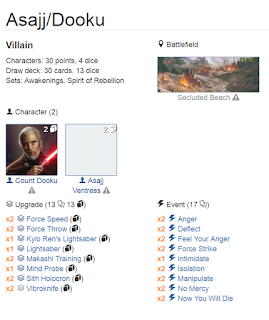Competitive Aspects of a deck in Star Wars: Destiny
Star Wars: Destiny (SWD) is unique as far as CCG/TCGs
go. The most visible difference is that
it utilizes dice alongside cards, and both are a very important part of
gameplay. In SWD, the actions we can
take are determined by what we roll, and while cards are also important, it's
generally much harder to win with cards than it is by simply rolling damage. In this post, I am going to discuss 4 key
aspects that are present in just about all strong performing SWD decks, and in
the future, I will discuss how all 4 of these aspects are present in the decks that I analyze.
In SWD, there are many different types of cards and card
effects, with a main deck being only 30 cards.
Generally, about half of the cards in any deck will consist of upgrades
or supports that provide their own dice, as more dice means a higher chance to
roll damage, but that only leaves room for around 15 events or support
cards! With so many options to choose
from, how can we separate the
good choices from the bad choices?
Here is some criteria to consider when looking at a
particular card or a deck:
- Consistency: Every action we take is determined by what we roll on our dice. In SWD, damage generally comes first, and any special effects that help deal damage is generally very powerful. However, the dice do not always roll in our favor, and when they don't, it's important to have a backup plan that isn't just "discard a card to reroll", as the discard plan is a generic plan that every player has access to. Having cards that increase consistency and deal damage or otherwise progress your game plan without needing to depend on rolls will give you an edge over any opponent that doesn't bring similar tricks to the table. Cards that can boost your consistency are Fight Dirty, Force Strike, and It's a Trap!. Generally, look for cards that allow you to utilize your poor dice rolls without losing actions, but ways to manipulate or reroll your own dice to more favorable sides, such as using focus sides and with cards like use the force, unpredictable, or power of the dark side, also boost consistency.
- Defense: Defense refers to the ability to delay character deaths, which can be achieved in many different ways, which include, but may not be limited to: gaining shields, healing damage, removing dice, or moving damage to a different target that is not the focus of the opponent. In general, heroes have more options to obtain shields and heal, but villains have more options to remove dice. Dice removal is stronger for a more proactive style of defending characters since removal cannot remove the damage that is already present on your characters, while healing and gaining shields is a more proactive approach, and can mitigate damage that has been dealt. There are many cards that can be used for defense, common ones include electroshock, field medic, defensive stance, and isolation.
- Action-Efficiency: In SWD, both players take turns performing actions, with each round essentially being a race to perform all actions that progress the game state more quickly than the opponent in order to claim the battlefield. Claiming the battlefield offers a distinct advantage, as having the ability to take the first activation is important to get value out of a character that has a lot of damage, or to simply take out an opposing character as quickly as possible. Action-efficiency refers to having abilities that support either taking additional actions or performing actions during points where you normally wouldn't be able to perform actions, and for a deck to be able to resolve all of its dice as quickly as possible. Essentially, the best kind of action-efficiency is the ability of a deck to interact in a way that it "cheats" the activation system. Cards and interactions with strong action-efficiency include Jango Fett, Rey + Holdout Blaster, tactical mastery, all-in, and basically any card with the ambush keyword.
- Burst Damage: In a game where you take turns with your actions, and are unable to interact with your opponent outside of your action, being able to do a large amount of damage without your opponent being able to react is a very powerful play. Although every deck is capable of resolving a large amount of damage on a good roll, the best decks are capable of having a surprise source of damage when the rolls may not necessarily be favorable. Event cards that deal damage are very powerful, as they are not easy to predict like dice in the dice pool. Having cards that can suddenly deal damage from your hand can catch your opponent off guard, perhaps causing them to lose a character that they didn't expect to lose, or force them to play defensively. Putting your opponent on the backfoot is a good way to secure wins and keep an advantageous position during the game, and burst damage, or the threat of burst damage, may force your opponent to make suboptimal plays as a reaction. Good examples of cards that can do burst damage are no mercy, fight dirty, force strike, riposte, and leadership
While there may be other aspects to deck building and other
important mechanics to consider in your decks that aren't mentioned here, such
as discard, economy, and more, I find these four traits to be present in some
way, shape, or form in just about every strong performing deck. Look for how your deck embodies these traits,
and keep them in mind when designing a deck.

Comments
Post a Comment